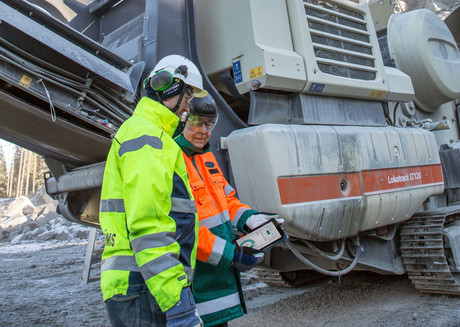Digitalisation in the aggregates industry — what does it all mean?

Giuseppe Campanelli, VP of Lifecycle Services for Metso, talks about digitalisation and how it can assist in the aggregates industry.
What are the main challenges facing aggregate producers today?
The main challenge facing our clients in today’s markets is how to make their operations more efficient and therefore more profitable. Key to building better efficiency is having the right information at your fingertips to help make the right decisions. With mobile crushing and screening equipment frequently moving between sites, often in remote locations, it can be difficult to track, monitor and maintain fleets of equipment for maximum performance. The often-conflicting pressures to drive performance while keeping costs in check can also be problematic. When a decision is made without the correct information or data, the result can be extended downtime or lower production rates, which impacts the bottom line of any operation.
What trends are you seeing in the industry to address these challenges?
We are seeing more and more aggregate producers focusing on their core business while turning to partners to find smarter, more efficient ways to design, operate and service their equipment and processes. Services and tools that can help address things such as utilisation rates, maintenance planning and spares management are all being looked at by our clients to help lower costs.
Can digitalisation solve the aggregates industry’s production issues?
No. Digitalised sensors and tools are only part of the solution. The industry needs a solution that can provide a range of operational and maintenance data on a single crusher or an entire crushing and screening fleet. Once a trend or outlier is identified, steps can be taken to address the issues. The key is having the know-how to analyse the data provided by such a digital solution. This is where the expertise provided by companies such as Metso and our partners makes the difference. Using decades of crushing and screening experience acquired though working with customers around the world, coupled with an intimate knowledge of our equipment, means that operators can rely on us to provide solid recommendations that can help them to get more out of our equipment and their process.
You recently launched a new digital solution, Metso Metrics Services. Can you explain what it is exactly?
Metso Metrics Services is a remote monitoring and reporting system that gives our customers access to key operational metrics and data. It allows utilisation rates, production levels, maintenance plans and fuel consumption for mobile equipment to all be remotely accessible by authorised personnel wherever they happen to be. The solution also helps track the location of a single unit or an entire fleet, no matter where they are located. Timestamped alarm notifications and maintenance planning, as well as logging capabilities, are also built-in. By accessing the right information at the right time, an operator can maximise equipment utilisation and minimise maintenance-related costs, helping them to achieve their business goals.
How can such a solution help operators get more out of their existing assets?
One key way it can help is by providing the data to see how each crusher in your fleet is performing in terms of production levels and utilisation rates. By looking at outliers, customers, supported by Metso when needed, can quickly identify underperforming assets. The interesting part then becomes trying to understand what is causing the underperformance. Is the machine set up with the right operating parameters? Is the equipment out of action because the right spare parts aren’t readily available? It could also be a question of a need for operator training to push the equipment to its full capabilities. Metso Metrics Services will not identify the exact cause of underperformance for you, but it will help you to start asking the right questions. You need to have the data to analyse in order to spot these types of situations. With additional support, insights and expertise in terms of operational or maintenance planning, there are opportunities to make a big difference in terms of performance.
How do such digital solutions help with maintenance planning?
They help by shifting the focus away from corrective maintenance and more towards preventive maintenance. Corrective maintenance has been shown to be many times more costly than preventive maintenance, the reason being that when assets fail in the field, production is often interrupted, resulting in costly downtime. Parts may not be readily available or may be on order, causing further delays. Repair staff may not be available immediately or allocated to other sites. With a built-in digital log book, individual maintenance plans integrated into the system and access to optional troubleshooting advice, customers gain visibility of their equipment to help them take the next step towards having a true preventive maintenance program. This in turn helps to minimise unwanted service issues in the field and ensures that operations are run in the most cost-effective manner.
Artificial intelligence: the fifth industrial revolution
AI in the industrial sector offers substantial advantages, but it is not without its challenges.
Building a critical infrastructure security dream team
Today it’s essential to have a strong cyber strategy, with all corners of the business...
Anticipating maintenance problems with predictive analytics
By utilising predictive analytics, process manufacturers can predict failures, enhance...








